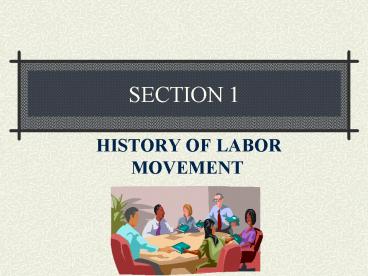HISTORY OF LABOR MOVEMENT - PowerPoint PPT Presentation
1 / 12
Title:
HISTORY OF LABOR MOVEMENT
Description:
High demand for labor in colonies. Most were self-employed artisans ... Skilled tradesmen started to work as 'journeymen' under 'master workmen' in small retail shops ... – PowerPoint PPT presentation
Number of Views:3155
Avg rating:5.0/5.0
Title: HISTORY OF LABOR MOVEMENT
1
SECTION 1
- HISTORY OF LABOR MOVEMENT
2
Colonial America (1619- 1776)
- High demand for labor in colonies
- Most were self-employed artisans
- Maximum wages established early
3
Centers of population begin to grow
- Skilled tradesmen started to work as
journeymen under master workmen in small
retail shops - Labor disputes are recorded back from 1630s
- Perhaps 1st actual strike in 1768
- No continuous labor organization yet
4
1780s?1800s
- Mutual Aid societies
- Out of need of post-revolutionary period
- First Union
- 1794, Federal Society of Journeymen Cordwainers
(Philadelphia) - all early unions craft-based
5
Transportation Revolution
- Markets widen (interior opens up) competition
increases - Employers interests in contrast with workers
interests - Workers protests general peaceful (for ?wages,
?hours, better conditions)
6
INDUSTRIALIZATION
- 1830s and on
- New class of factory workers
- Initially clean for Mill girls
- ?labor supply and competition again lead
employers to push. - 1st real attempt at National unions in 1850s
7
POST CIVIL WAR
- Knights of Labor (1869)
- 800,000 members by late 1880s
- Accepted skilled and unskilled
- Belief in political action, not strikes.
- Key flaw was focus on moral philosophies instead
of short-term economic interests of workers. - Quick demise in 1890s precipitated by HayMarket
Riot (1886)
8
American Federation of Labor (AFL)
- 1886 Key founder is Gompers
- Established as a Federation, not a union, of
largely craft unions - Basic philosophy
- Promote capitalism, but improve material needs of
members - Belief in strikes, govt acceptance
9
AFL survives key incidents
- Homestead Incident (1892)
- AFL shows solid material support
- Media criticizes Carnegie
- Pullman Strike (1894)
- AFL chooses to not help ARU strike
- Debs ?prison?radicalized (socialist)
10
IWW (1905)
- Threatening because of left-winged, radical
views (overthrow capitalism) - Downfall by 1918 due to
- Financial troubles
- No focus on short-term material interests
(similar flaw of KOL) - Identification with violence and sabatoge (check
out their website) - Stance against U.S. war effort
11
WWI-WWII
- Welfare Capitalism
- Depression Era legislation
- CIO splits from within AFL (1938)
12
WWII-present (roughly)
- General decline in unionization
- AFL-CIO merger (1955)
- Anti-corruption legislation for unions coming out
of 1950s - Dealing with increased global competition
- AFL-CIO new president (1995) Sweeney

